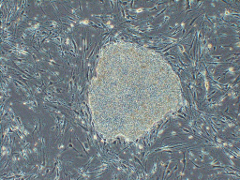 An iPS cell
An iPS cell
In research recently published in Cell Cycle, a group of scientists led by Piero Carninci of the RIKEN Center for Life Science Technologies analyzed the genes that are transcribed in the nuclei of embryonic stem cells and iPS cells—a type of cell that is reprogrammed from normal somatic cells with the intention to have them act like stem cells—and discovered that there are significant differences between the two.
There has been discussion in recent years about whether iPS cells—which are reprogrammed through the insertion of four “Yamanaka’s factors”—are really functionally equivalent to the stem cells they are supposed to substitute for, and as a result, whether the current technology for producing these cells is adequate. iPS cells have attracted attention for their potential role in regenerative medicine, since, unlike embryonic stem cells, they can be derived from cells taken from the patient’s own body, eliminating some thorny ethical issues.
The researchers used CAGE, a technology developed at RIKEN that identifies the starting points of RNA transcription, to compare five iPS cell clones derived from mouse immune cells and three embryonic stem cell lines. What they discovered is that the nuclear gene expression patterns shown by the pattern of DNA transcription are much more complex in the embryonic stem cells than in the iPS cells. They found certain DNA regions, known as “super-enhancers,” that are active in the embryonic stem cells but not iPS cells, which are associated with genes that are believed to be involved in pluripotency—the defining feature of stem cells. They also found “non-coding” RNAs—which are not translated into proteins—expressed by super-enhancers in the embryonic stem cells.
What these findings signify, according to Carninci, is that “current iPS cell programming protocols do not create cells that are functionally identical to natural embryonic stem cells, and this means that we have to be cautious when using such cells. I would emphasize, though, that nuclear CAGE technology has allowed us to see the differences clearly, and this means we have a new tool at our disposal to better understand what we bring into therapy."
